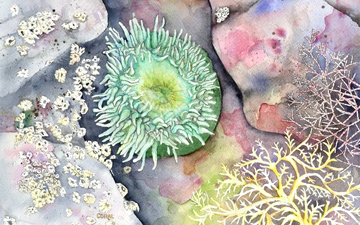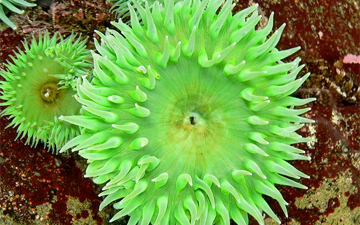Anthopleura xanthogrammica, or the Giant Green Anemone, is a species of intertidal sea anemones, of the family Actiniidae.
Other common names: Green Surf Anemone, Giant Green Sea anemone, Green Anemone, Giant Tidepool Anemone, Solitary Anemone, and Rough Anemone [1]
The column width and height can reach a maximum of 17.5 [2] and 30 cm, respectively.[3] The crown of tentacles can be as wide as 25 cm in diameter,[3] while the column, itself, tends to be widest at the base in order to offer a more stable connection to the rocks.[4]
It has a broad, flat oral disk surface [5] and no striping, banding, or other markings [4]
If A. xanthogrammica is exposed to proper amounts of sunlight, it can appear bright green[4] when submerged under water.
When not submerged, it appears dark green or brown. This is because the anemone tends to close up and “droop” and its now exposed column is actually dark green and slightly brown, but the hidden tentacles and oral disk are bright green.[2]
(From Wikipedia, September 6th, 2010)
– – –
Anthopleura xanthogrammica tends to lead a solitary life in the intertidal. Although it can move slowly through the use of its basal disk, it usually will stay attached as the tides move in and out. To prevent dessication, Anthopleura xanthogrammica will retract its tentacles and close up during low tides (Giant, 1998). Common predators of Anthopleura xanthogrammica include the nudibranch Aeolidia papillosa and the snail Epitonium tinctum, both of which feed on the tentacles, and the snails Opalia chacei and Opalia funiculata and the sea spider Pycnogonum stearnsi all of which feed on the column. In some geographic regions these anemones have been preyed upon by the sea star Dermasterias imbricata. Anthopleura xanthogrammica can defend itself using stinging cells located in the tentacles. However, these have little affect against larger invertebrates as well as vertebrates (Morris,et al.,1992).
(via Animal Diversity Web via EOL, September 6th, 2010)
– – –





